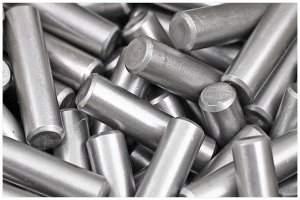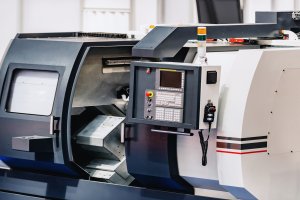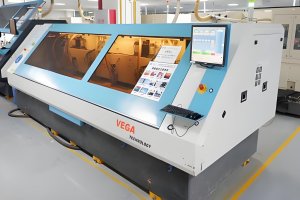Introduction
The density of steel is a defining characteristic that shapes its use across industries, from constructing skyscrapers to crafting intricate components through CNC machining. As an engineer with years of experience in material selection and precision manufacturing, I’ve seen firsthand how the density of steel influences structural design, cost estimation, and machining outcomes. Whether you’re an architect calculating loads, a manufacturer optimizing production, or a machinist programming a CNC lathe, understanding the density of steel is critical. This guide dives deep into the density of steel, exploring its dependence on alloy composition, its impact on CNC machining, and practical applications, enriched with my insights from working with steel in real-world projects.
Understanding the Density of Steel: The Foundation
The density of steel is typically quoted as 7.85 g/cm³ (7850 kg/m³, 490 lb/ft³, or 0.283 lb/in³) for standard carbon steels. However, depending on the alloy, the density of steel can range from 7.75 to 8.05 g/cm³. This variation arises from the blend of elements mixed with iron, which directly affects weight and performance in applications like CNC machining. For instance, when I worked on a project designing precision gears for an automotive client, selecting a steel with the right density was crucial to balance weight and durability while ensuring machinability on a CNC mill.Density Defined: Density (ρ) is the mass (m) per unit volume (V), calculated as ρ = m/V. This property remains constant whether you’re handling a small CNC-machined bolt or a massive structural beam. In my experience, the density of steel is a bridge between theoretical design and practical execution, enabling precise weight calculations for everything from shipping logistics to machine tool settings in CNC machining.
Alloy Composition and Its Impact on Steel Density
The density of steel is primarily determined by its alloying elements. Pure iron has a density of 7.87 g/cm³, but additives like nickel, chromium, or molybdenum alter this value significantly:
- Dense Elements: Nickel (8.91 g/cm³) and molybdenum (10.22 g/cm³) increase the density of steel. Austenitic stainless steels, such as 304 (7.93 g/cm³) and 316 (8.00 g/cm³), are denser due to their high nickel content, making them ideal for corrosion-resistant parts but heavier in CNC machining setups.
- Lighter Elements: Chromium (7.19 g/cm³) or silicon (2.33 g/cm³) reduce the density of steel. Ferritic stainless steels like 430 (7.70 g/cm³) are lighter, which I’ve found advantageous when machining lightweight brackets on a CNC router to minimize tool wear.
Here’s a detailed reference for the density of steel across common grades, which I often consult when selecting materials for machining projects:
| Steel Category | Specific Grade(s) | Density (kg/m³) | Density (g/cm³) | Density (lb/in³) |
| Carbon Steel | AISI 1018, A36 | 7850 | 7.85 | 0.283 |
| Austenitic Stainless | 304, 316 | 7930–8000 | 7.93–8.00 | 0.286–0.289 |
| Ferritic Stainless | 430 | 7700 | 7.70 | 0.278 |
| Martensitic Stainless | 410, 440C | 7620–7750 | 7.62–7.75 | 0.275–0.280 |
| Tool Steel | M2, T1 | 8150–8500 | 8.15–8.50 | 0.294–0.307 |
| Maraging Steel | Grade 250 / 300 | 8100 | 8.10 | 0.293 |
Data sourced from industry standards.In my work with CNC machining, I’ve noticed that denser steels like M2 tool steel (8.15 g/cm³) require slower cutting speeds to avoid excessive tool wear, while lighter grades like 430 allow faster machining, boosting efficiency. This interplay between the density of steel and machining parameters is a critical consideration in my shop.
External Factors Influencing the Density of Steel
Beyond alloy composition, external conditions affect the density of steel:
- Temperature: When steel is heated, it expands, increasing volume and reducing the density of steel. I’ve encountered this in CNC machining when working on parts for high-temperature environments, like turbine blades, where thermal expansion must be factored into tolerances.
- Corrosion: Rust, formed by iron reacting with oxygen, is less dense than steel, increasing volume and compromising structural integrity. In a coastal project I consulted on, we chose 316 stainless steel for its corrosion resistance, despite its higher density of steel, to ensure longevity.
The Density of Steel in CNC Machining: My Experience
In CNC machining, the density of steel directly impacts tool selection, cutting parameters, and production costs. When machining a batch of AISI 1018 carbon steel components (7.85 g/cm³) for an industrial client, I found its moderate density ideal for maintaining dimensional stability without overburdening the CNC spindle. However, when working with denser 316 stainless steel, I had to adjust feed rates and use carbide tools to handle the material’s toughness, which increased machining time but ensured precision.One memorable project involved machining maraging steel (8.10 g/cm³) for aerospace components. Its high density of steel posed challenges in achieving tight tolerances, but by optimizing coolant flow and tool paths, we delivered parts that met stringent specifications. This experience taught me that understanding the density of steel is as much about machining strategy as it is about material selection.
Comparing Steel Density to Other Materials
The density of steel positions it as heavier than lightweight materials but competitive in strength and cost. Here’s how it stacks up:
| Material | Density (g/cm³) | Density Relative to Steel | Key Characteristics |
| Aluminum | 2.70 | ~34% | Lightweight, corrosion-resistant |
| Titanium | 4.51 | ~57% | High strength-to-weight, costly |
| Steel (Carbon) | 7.85 | 100% | High strength, affordable |
| Steel (316) | 8.00 | ~102% | Corrosion-resistant, durable |
| Copper | 8.96 | ~114% | High conductivity |
| Concrete | 2.40 | ~31% | Strong in compression, low cost |
Data compiled from industry sources.In CNC machining, I often choose steel over aluminum for its durability, despite its higher density of steel, especially for high-wear parts like gears or shafts. Titanium, while lighter, is cost-prohibitive for most projects I’ve handled, making steel the go-to choice for balancing performance and budget.
Calculating Steel Weight: Practical Applications
The density of steel is key to calculating component weights, which is vital in both design and CNC machining. Here are two examples:
- Steel Plate: For a 48-in × 24-in × 0.5-in carbon steel plate (density 0.283 lb/in³), the weight is:
Weight = 48 × 24 × 0.5 × 0.283 = 163.0 lb. This calculation helped me estimate material costs for a structural project. - Steel Pipe: For a 2-m pipe with a 100 mm OD, 90 mm ID, and density 7850 kg/m³, the weight is:
Weight = π × [(0.1² – 0.09²) / 4] × 2 × 7850 = 23.4 kg. I used this formula to verify shipping weights for a batch of CNC-machined pipes.
In CNC machining, these calculations ensure that fixtures and workholding systems can handle the component’s weight, preventing vibrations that could affect precision.
Why the Density of Steel Matters in Design and Machining
The density of steel is more than a number—it’s a gateway to informed decision-making. In my career, I’ve seen how selecting a steel with the right density can make or break a project. For a marine application, I recommended 316 stainless steel (8.00 g/cm³) for its corrosion resistance, despite its higher density of steel, to ensure durability in harsh conditions. Conversely, for a cost-sensitive automotive part, I opted for AISI 1018 (7.85 g/cm³) to keep weight and machining costs down.In CNC machining, the density of steel influences tool life, cycle times, and energy consumption. Denser steels require robust tooling and precise programming, but their strength justifies the effort. My advice? Always cross-reference the density of steel with your project’s requirements—whether it’s weight, machinability, or environmental resistance—to achieve optimal results.
My Perspective on Steel Density in Modern Engineering
Reflecting on my years in the field, I believe the density of steel is often underappreciated. It’s not just about weight; it’s about how that weight interacts with design constraints, machining processes, and end-use performance. When I started, I underestimated how much the density of steel would affect CNC machining outcomes. A poorly chosen steel grade led to excessive tool wear on a high-speed project, costing us time and money. That lesson drove home the importance of aligning material density with machining capabilities.Today, with advanced CNC machining technologies, we can push the limits of dense steels like tool steel T1 (8.50 g/cm³) for high-performance tools. But it’s a balancing act—denser steels demand more energy and precision, while lighter grades like 430 stainless (7.70 g/cm³) can streamline production. My approach is to treat the density of steel as a starting point, then layer in project-specific factors like corrosion resistance or cost.
Conclusion
The density of steel, averaging 7.85 g/cm³, is a cornerstone of its versatility in engineering and CNC machining. Shaped by alloy composition, it dictates weight, machinability, and performance. From my experience, mastering the density of steel unlocks smarter material choices, whether you’re machining precision parts or designing resilient structures. Factors like temperature and corrosion add complexity, but they’re manageable with the right knowledge. For your next project, consider how the density of steel can optimize both design and production.
FAQ:
1. What is the density of steel, and why does it matter in engineering?
The density of steel is typically 7.85 g/cm³ for carbon steels, ranging from 7.75 to 8.05 g/cm³ depending on the alloy. It’s crucial because the density of steel determines a component’s weight, impacting structural design, transportation costs, and material selection. In my experience as an engineer, knowing the density of steel ensures accurate load calculations for projects like bridges or CNC-machined parts, preventing costly missteps.
2. How does alloy composition affect the density of steel?
Alloying elements like nickel (8.91 g/cm³) increase the density of steel, as seen in 316 stainless steel (8.00 g/cm³), while lighter elements like chromium (7.19 g/cm³) reduce it, as in 430 stainless (7.70 g/cm³). I’ve found that choosing the right alloy based on the density of steel is key in CNC machining to balance weight and machinability. For example, denser steels require slower cutting speeds to preserve tool life.
3. How does the density of steel impact CNC machining?
The density of steel affects tool selection, cutting speeds, and cycle times in CNC machining. Denser steels like M2 tool steel (8.15 g/cm³) demand robust carbide tools and precise programming, as I learned when machining aerospace components. Lighter steels like 430 stainless (7.70 g/cm³) allow faster machining, reducing costs. Understanding the density of steel helps optimize machining efficiency and part quality.
4. How can I calculate the weight of a steel component using its density?
To calculate weight, multiply the volume by the density of steel. For a steel plate (48 in × 24 in × 0.5 in, density 0.283 lb/in³), the weight is: 48 × 24 × 0.5 × 0.283 = 163.0 lb. For a pipe, use: Weight = π × [(OD² – ID²)/4] × Length × Density. I’ve used these formulas in CNC machining to ensure fixtures can handle component weights, avoiding vibrations that affect precision.
5. How does temperature affect the density of steel?
Heating steel causes thermal expansion, increasing volume and reducing the density of steel. In CNC machining projects for high-temperature environments, like turbine blades, I account for this to maintain tolerances. For example, a steel part at 500°C may expand slightly, lowering its effective density of steel, which must be considered in design and machining.
6. Why is stainless steel denser than carbon steel?
Stainless steels, like 304 (7.93 g/cm³) or 316 (8.00 g/cm³), contain dense elements like nickel, increasing their density of steel compared to carbon steel (7.85 g/cm³). In my work, I’ve chosen 316 for marine projects due to its corrosion resistance, despite its higher density of steel, while carbon steel suits cost-sensitive CNC machining tasks.
7. How does corrosion impact the density of steel?
Corrosion forms rust, which is less dense than steel, increasing volume and weakening components. In a coastal project I consulted on, we selected 316 stainless steel to minimize rust’s impact, as its higher density of steel was offset by superior durability. This choice ensured long-term performance without compromising the density of steel in calculations.
8. How does the density of steel compare to other materials?
The density of steel (7.85–8.05 g/cm³) is higher than aluminum (2.70 g/cm³) or concrete (2.40 g/cm³) but similar to pure iron (7.87 g/cm³). In CNC machining, I prefer steel over aluminum for its strength, despite its denser profile, as it withstands high-wear applications like gears. Titanium (4.51 g/cm³) is lighter but too costly for most projects I handle.
Reference:
https://en.wikipedia.org/wiki/Steel;
https://en.wikipedia.org/wiki/Densities_of_the_elements_(data_page);
https://warbletoncouncil.org/propiedades-mecanicas-fisicas-acero-4084;
https://hypertextbook.com/facts/2004/KarenSutherland.shtml;
Other Articles You Might Enjoy
- Mastering MagnaCut Steel with CNC: Tips for Precision Knife Crafting
Introduction MagnaCut Steel has taken the knife-making world by storm, and for good reason. This powder metallurgy stainless steel offers an incredible balance of hardness, toughness, and corrosion resistance, making…
- Best Cutting Tools and Feeds for HSS Steel Machining
I. Introduction: What is HSS (High-Speed Steel)? High-speed steel (HSS) is an alloy designed to withstand the intense heat generated during cutting operations. It’s not only used for tool manufacturing…
- S30V Steel CNC Machining Guide: Tools, Techniques, and Real-World Tips
Introduction When I first started working with S30V steel, I thought I knew what I was doing. I had years of CNC machining experience, a decent tool library, and a solid…
- Precision Meets Performance: A Comprehensive Guide to CNC Machining of M390 Steel
Introduction When I first encountered M390 steel, I wasn't aware of the challenges and possibilities this remarkable metal offered. My experience began in a CNC workshop, facing persistent tool wear and…
- What Makes 1095 Steel Ideal (or Not) for CNC Projects
Introduction Choosing the right material for CNC machining can make or break your project. It’s not just about whether a material is hard or tough. It’s about how it behaves…






